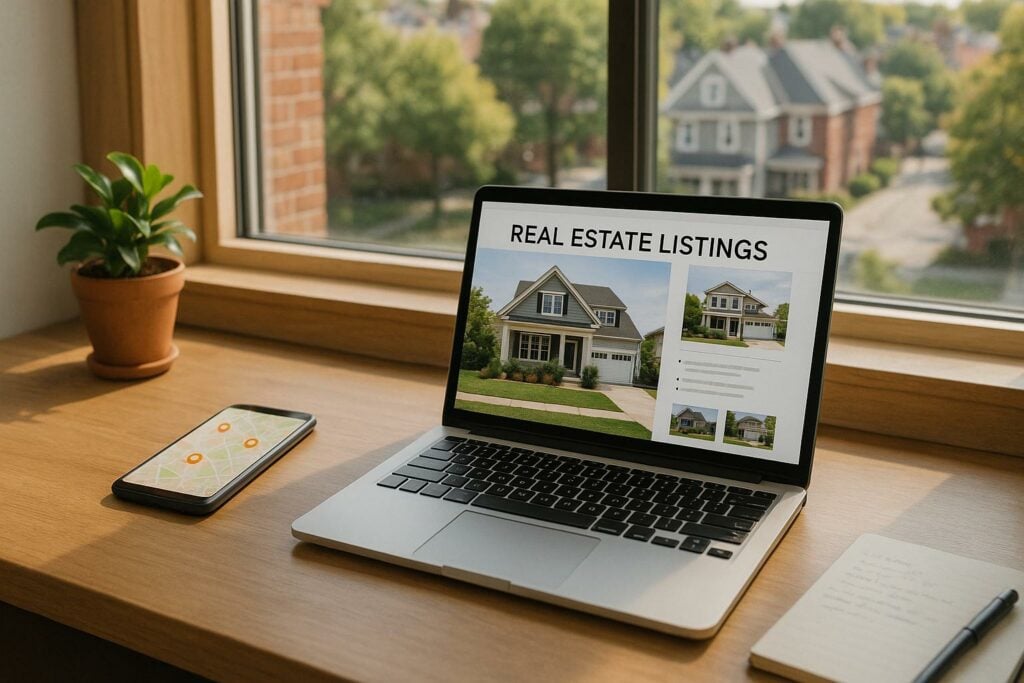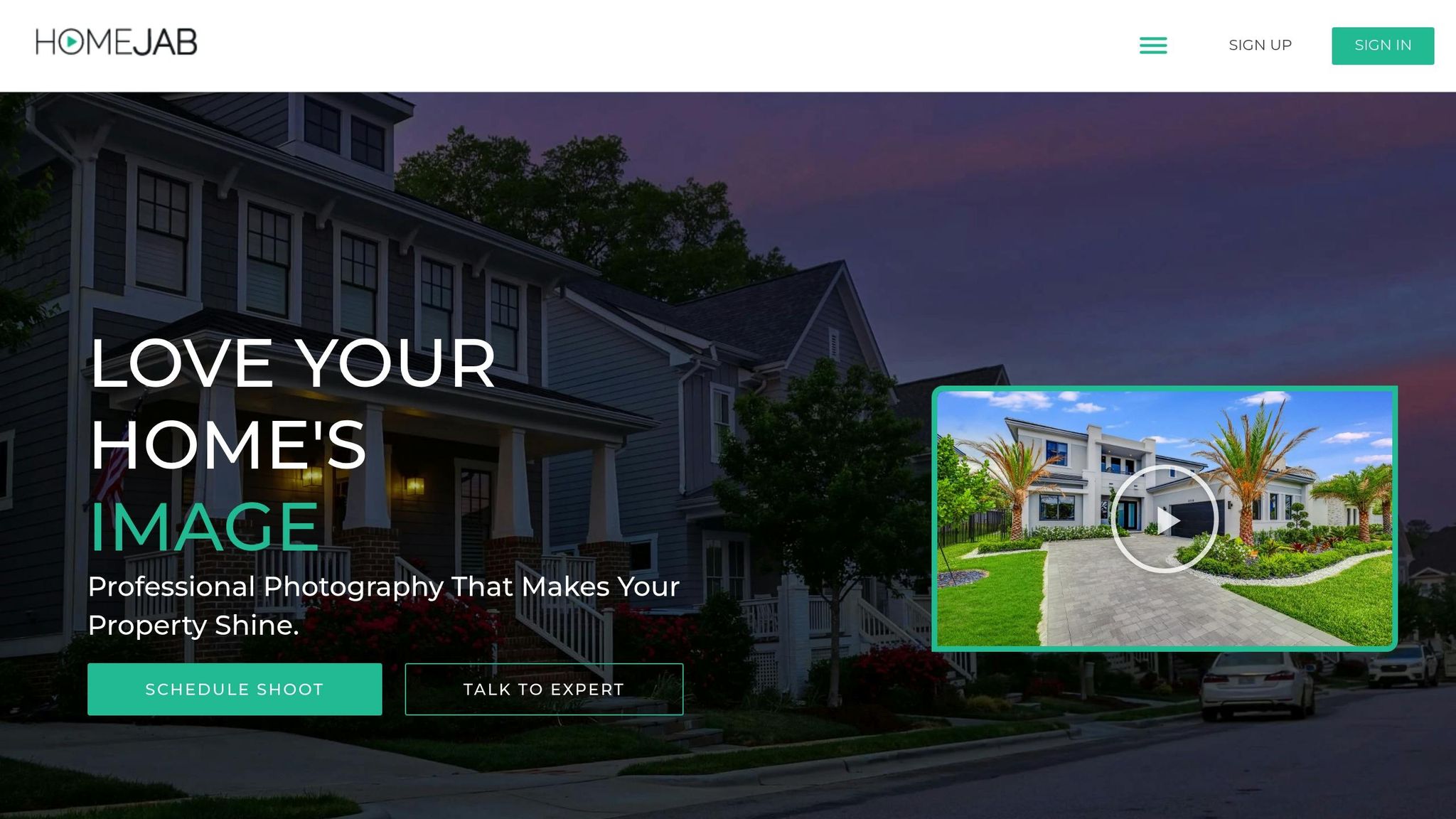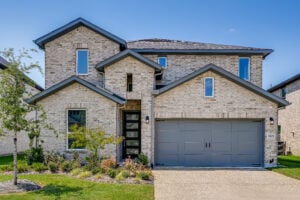Want your real estate listings to show up in local searches? Here’s how to do it:
- Use Local Keywords: Add location-specific terms like "homes near Central Park" or "condos in downtown Dallas" in titles, headings, and descriptions.
- Highlight Nearby Features: Mention schools, parks, transit options, and landmarks to make your listings stand out.
- Add Schema Markup: Use structured data to display details like price, property type, and features in search results.
- Invest in Professional Media: High-quality photos, 3D tours, and videos can boost engagement and help your listings rank higher.
- Set Up Local Citations: Ensure your business details (name, address, phone) are consistent across platforms like Google, Yelp, and Zillow.
- Optimize for Mobile: Make your listings fast and easy to view on mobile devices – 70% of homebuyers search on their phones.
Why it matters: 97% of buyers start online, and mobile "near me" searches have exploded by over 500%. These steps ensure your listings rank higher and attract serious local buyers.
Now, let’s dive into the details.
How Real Estate Agents Can Dominate SEO Local Search: Market Movers Podcast Guest Appearance
On-Page SEO for Real Estate Listings
Fine-tuning your property listing pages can significantly improve their visibility in local search results. By optimizing elements directly on your website, you not only make it easier for search engines to understand your content but also make it more appealing to prospective buyers searching for homes in specific neighborhoods. These on-page techniques complement the broader local SEO strategies discussed earlier. Let’s dive into how you can make your pages more relevant by incorporating precise local keywords.
Adding Local Keywords to Your Listings
The language you use in your property descriptions should match the terms potential buyers are typing into search engines. Incorporate location-specific keywords into your page titles, headings, and the opening lines of your descriptions. For example, instead of generic phrases, use targeted long-tail keywords like "single-family homes in the north Burbank area" to attract buyers with specific needs.
Free tools like Term Explorer and WordStream can help you uncover the phrases that resonate most with your audience. Additionally, creating dedicated neighborhood pages that discuss local history, demographics, amenities, market trends, or even unique weather patterns can give your site an edge in local rankings. Just ensure your keywords flow naturally within the content – forced or excessive keyword use can backfire.
Mentioning Nearby Landmarks and Amenities
Detailed, hyper-local descriptions can make your listings stand out. Buyers want a clear picture of a property’s surroundings, so go beyond generic labels like "homes in Boston." Instead, craft engaging descriptions such as "Victorian-style homes in Boston’s historic Beacon Hill, steps from the State House".
Highlighting nearby schools, parks, shopping centers, and public transit options can provide the context buyers are looking for. You can even include details like commute times or the distance to major transit hubs to emphasize the convenience and lifestyle that come with the location.
Adding Schema Markup to Property Pages
Schema markup is a powerful tool for making your listings stand out in search results. By implementing property and local business schema, you can showcase essential details like price, square footage, location, and features as rich snippets. For example, include specifics such as property type (condo, townhouse, single-family home), year built, lot size, and any standout features like a pool or garage. This not only helps search engines understand your content but also builds trust with potential buyers by presenting key information upfront.
You can take it a step further by adding review schema to display client testimonials and ratings directly within search snippets. This feature can increase click-through rates and establish credibility with buyers right from the search results page.
Using Professional Photos and Media
Visual content can do wonders for your local SEO by increasing user engagement and signaling search engines that your content is worth ranking. High-quality visuals not only enhance your on-page SEO but also attract more potential buyers, making them a must-have for any real estate listing.
Professional Photography for Better Listings
The quality of your property photos plays a huge role in grabbing buyer attention and boosting search engine visibility. In fact, listings with professional photos see 118% more online views and help properties sell 32% faster compared to those with amateur images. Skilled photographers know how to showcase a property’s standout features – whether it’s an ocean view or unique architectural elements. Re-shooting a listing to highlight these details can significantly reduce the time a property spends on the market and even increase its sale price.
Using techniques like HDR imaging, drone photography, and walkthrough videos creates a complete visual story that not only engages buyers but also supports your SEO goals. Professional photos can even add $3,000 to $11,000 to a home’s sale price, making them a smart investment for both marketing and SEO.
3D Tours and Virtual Staging
Interactive media takes visual content to the next level by driving even greater engagement. Listings with video content, for example, generate 403% more inquiries, and properties with virtual tours spend up to 31% less time on the market. Virtual tours let buyers explore properties at their own pace, providing a better sense of the layout and flow.
Virtual staging is another game-changer. By digitally furnishing empty spaces, you can help buyers imagine the potential of a home without the cost or hassle of physical staging. This keeps your listing visually appealing while showcasing how a space can be utilized.
How HomeJab Helps with Professional Media
HomeJab is a platform that connects real estate professionals with experienced local photographers who specialize in property marketing. Their services include everything from HDR photography and drone footage to 3D virtual tours and virtual staging, all aimed at making your listings stand out. They even ensure fast delivery, with most projects completed within 24 hours, so you can get your listings online quickly.
HomeJab’s photographers are well-versed in real estate marketing requirements, such as proper image sizing for MLS platforms and SEO-friendly file naming, which helps search engines understand and rank your content. Media packages start at $175, with bulk pricing options available, making it easy to maintain high-quality visuals across multiple listings. By improving your listing’s visual appeal and engagement, HomeJab’s services give your local SEO efforts a noticeable boost.
Setting Up Local Citations
Once your visual media is in great shape, the next step to solidify your local presence is to focus on accurate citations. Local citations are online mentions of your business details – like your name, address, and phone number – that confirm your location and help improve your local search rankings. Did you know that 50% of local businesses have incorrect mentions online? Fixing yours can give you a serious edge over the competition.
But citations do more than just boost SEO rankings. When your business information is consistent across various platforms, it builds trust – not only with search engines but also with potential clients. For instance, businesses that rank in the top three local search results typically have around 81 citations. This shows just how important both the quantity and accuracy of your citations are for standing out locally.
Setting Up Your Google Business Profile
Your Google Business Profile (GBP) is a free, powerful tool to manage how your business appears on Google. It’s a game-changer for local search rankings and makes it easier for potential clients to discover your real estate services.
Scott Vancea, a marketing expert, emphasizes how underused GBP is in real estate. He explains:
"Think of your Google Business Profile as the first impression users will have of your business."
Start by claiming and verifying your GBP. This gives you full control over your business details and unlocks useful features. Verification usually involves receiving a postcard at your business address with a code from Google, though phone verification may sometimes be an option.
Once verified, focus on creating a compelling description that highlights your expertise. Be specific – mention services like luxury waterfront properties or first-time homebuyer assistance. Choose accurate categories and upload high-quality photos and videos that showcase your team, office, and properties you’ve sold. Regularly posting updates through Google Posts keeps your profile active and signals to Google that your business is engaged and relevant.
Keeping Your Business Information Consistent
Consistency in your business details is the backbone of effective local SEO. Your Name, Address, and Phone number (NAP) must match across all platforms. Any discrepancies can hurt your rankings and erode trust with potential customers.
In fact, 73% of consumers lose trust in a brand when they find incorrect information online. This can have real consequences – clients may struggle to contact you or even question your professionalism when they encounter conflicting details.
"Consistent NAP information across various online platforms helps search engines like Google and Bing understand and validate the legitimacy of your business. This, in turn, helps your business rank higher in local search results, making it easier for potential customers to find you." – GoSite Team
To ensure consistency, create a standardized format for your business details and stick to it. For example, if your address is "123 Main Street", avoid using variations like "123 Main St." across different platforms. Use a local phone number instead of a toll-free 1-800 number to reinforce your local presence.
Claim and verify your listings on major directories like Yelp, Facebook, Zillow, Realtor.com, and even local chamber of commerce websites. Keep your business hours up to date, including special holiday hours, and make sure your details are consistent across social media and other online platforms. Tools like Yext can help sync your data across multiple directories, while BrightLocal, Moz Local, and SEMrush are great for tracking and optimizing your citations. Regularly auditing your NAP details ensures any inconsistencies are caught and corrected before they impact your rankings.
Getting More Customer Reviews
Accurate listings are just part of the equation – customer reviews play a huge role in building your local credibility. Reviews act as trust signals that not only enhance your reputation but also improve your local search rankings. After successfully closing a sale, ask your clients for reviews. Make it easy for them by providing direct links and personalized prompts.
Always take the time to respond to reviews, whether they’re positive or negative. Thank clients for their kind words, and handle any negative feedback professionally. This kind of engagement shows you value their input and are committed to maintaining strong relationships with your customers.
sbb-itb-82c5f45
Making Listings Mobile-Friendly
In 2023, over 70% of homebuyers used mobile devices to search for their next home. That means your listings need to perform seamlessly on mobile screens. But this isn’t just about creating a smooth experience – it’s also a major factor in how well your site ranks locally. A mobile-first strategy is essential for capturing local leads and works hand-in-hand with your overall on-page SEO and citation efforts.
Google now prioritizes the mobile version of websites when determining search rankings. Combine that with the fact that "near me" searches have skyrocketed by over 500% in recent years, and it’s clear: mobile-friendly listings are a must for staying visible in local search results. As SEO expert Shwetabh Singh puts it:
"Mobile optimization is no longer optional; it’s a necessity for real estate SEO success."
Fast Loading and Mobile Design
Speed matters. 53% of mobile users will abandon a site if it takes more than three seconds to load. Even worse, bounce rates jump by 32% when load times increase from one second to three seconds. Every second shaved off your site’s load time can keep potential buyers engaged.
Take Century 21 as an example. Their website loads in just 1.2 seconds, thanks to streamlined code, caching, and a content delivery network (CDN). With a page size of only 4 MB, they’ve set the bar for mobile performance.
To achieve similar results, start with image compression. Images typically make up about 21% of a website’s total weight, so optimizing them can dramatically improve load times. Modern formats like WebP can shrink file sizes by 25-34% compared to JPEGs.
Beyond images, focus on minifying your code, enabling caching, and using a CDN for faster delivery. Implement lazy loading, which prioritizes loading content visible on the screen first, giving the impression of faster load times. Redfin uses this technique effectively, combining compressed images and lazy loading to create a smooth, fast experience that keeps users browsing.
Once your site is loading quickly, the next step is optimizing your visuals for mobile users.
Optimizing Photos and Videos for Mobile
Fast load times are only part of the equation – your visuals also need to shine on mobile devices. Since mobile users typically read just 20% of the text on a webpage, your photos and videos play a huge role in grabbing their attention.
Start by resizing images for mobile dimensions and using responsive design principles. Add descriptive alt text to help search engines understand your content. For file formats, JPEG works best for standard MLS listings and emails, while WebP is ideal for websites and virtual tours, offering smaller file sizes without sacrificing quality.
Zillow is a great example of mobile optimization done right. Their platform adjusts seamlessly to different screen sizes, making it easy for users to browse listings, view photos, and contact agents. With over 53% of their traffic coming from mobile devices, Zillow shows just how important it is to get this right.
For a more advanced approach, look to Compass. Their mobile site functions as a Progressive Web App (PWA), offering fast load times, offline access to property listings, and push notifications for updates on new properties and price changes. These features have helped them achieve conversion rates nine times higher, largely because of instant alerts.
Finally, include mobile-specific features like tap-to-call buttons and GPS-enabled maps. These small but impactful additions make it easier for users to contact you or navigate to a property, turning casual browsers into serious leads.
Tracking Your Local SEO Results
Once your listings are mobile-friendly, the next step is measuring their performance in local search results. Tracking is essential to understand your local SEO’s impact, especially since 97% of homebuyers start their search online. Without proper tracking, you risk missing opportunities to improve rankings and attract leads.
Google updates its search algorithm around 500 to 600 times annually. This means strategies that worked last month might no longer be effective. Regular tracking helps you identify trends early and adjust your approach before competitors gain an edge. It also reinforces the on-page and local citation strategies discussed earlier.
Monitoring Local Keyword Rankings
Start with free tools like Google Analytics and Search Console to establish a foundation for tracking. For deeper insights, consider tools like Ahrefs, SEMrush (starting at $119.95/month), Pro Rank Trackers (from $13.50/month), or SE Ranking (from $23.52/month) to monitor local keyword positions and citation growth. Google Search Console is especially useful as it reveals which keyword phrases drive traffic to your site.
Pay close attention to your rankings in the local map section of Google. This is often where local searches convert into leads. Look for steady improvement in keyword rankings – positive trends signal progress, while sudden drops may indicate optimization issues or technical errors.
It’s also important to track the leads and conversions your website generates alongside keyword rankings. This gives a clearer picture of your SEO efforts’ overall performance.
Checking User Engagement Data
Rankings only tell part of the story. You also need to understand how users interact with your listings once they find them. For example, the average time spent on a real estate page is 1 minute and 34 seconds. If your pages fall below this benchmark, they may need improvement.
While real estate websites typically attract 2.02K users monthly, which is below the all-industry median of 3.02K, they excel in other areas. The industry has a 46.85% bounce rate, significantly lower than the 60.78% median across all industries. This indicates that when users find real estate content, they tend to stay longer.
Focus on your click-through rates (CTR) from search results. Valerie Jennings, CEO of Jennings Social Media & MarTech, highlights the importance of clicks:
"Clicks are the biggest indicator of qualified traffic to your website. These users have made the extra step to seek additional information and often show a promising Conversion Rate."
Use Google Analytics to identify keywords with high impressions but low CTRs. These are missed opportunities – adjust your page titles and descriptions to better align with user searches.
A strong real estate website should aim for at least 30% returning visitors. If your rate is lower, focus on creating engaging content that encourages users to come back.
Updating Listings Based on Performance Data
Once you have engagement metrics, use them to refine and update your listings. Regularly review your analytics, update content monthly, and conduct full audits quarterly to stay ahead of market changes. Ali Hasan, Founder of Xorivotech, emphasizes the importance of consistency:
"SEO requires ongoing updates. Monitor analytics weekly, refresh content monthly, and conduct comprehensive audits quarterly."
Always update listings with new information, such as property details, photos, or market data. With "near me" searches increasing by over 900% in two years, maintaining local relevance is more critical than ever. Use your performance data to identify which local keywords drive the most qualified traffic, and focus on optimizing for those terms.
For websites with multiple property pages, ensure that pages aren’t competing for the same keyword. This type of internal competition can confuse search engines and hurt your rankings.
Finally, remember that the top three Google search results capture 54.4% of all clicks. If your listings aren’t in those coveted spots, analyze your competitors’ content and optimization strategies. Use this information to refine your own listings and improve your chances of ranking higher.
Key Points for Local SEO Success
To succeed in local SEO for real estate, four key elements need to work together seamlessly: strong on-page optimization, professional media, consistent business information, and mobile-friendly design. These components collectively strengthen your local search presence, helping you connect with serious buyers.
Professional media has a powerful impact on your listings. High-quality photos, 3D virtual tours, and aerial footage not only make your listings visually appealing but also signal to search engines that your content is worth engaging with. Companies like HomeJab provide top-tier media services, often delivering within 24 hours, to elevate your listings and drive more interest.
"Our high-quality real estate photos, videos, and interactive tours will supercharge your listings and help you sell quickly."
Equally important is ensuring consistent business information across all platforms. Search engines rely on uniformity to establish trust, so your business’s name, address, and phone number (NAP) must match exactly on every directory, social media profile, and listing site. Even small inconsistencies can confuse search engines and harm your rankings, making accuracy essential for boosting local SEO.
Mobile optimization is another critical factor, as most property searches now happen on mobile devices. Your listings should load quickly and display perfectly on smaller screens. This includes optimizing photos and videos for mobile without compromising quality, ensuring a smooth experience for potential buyers.
Finally, on-page SEO with local keywords ties everything together. By incorporating neighborhood names, nearby landmarks, and local amenities into your property descriptions, you help search engines pinpoint your properties’ locations and unique features. Using schema markup can further enhance your listings by enabling rich snippets that display property details, prices, and photos directly in search results.
FAQs
How can I use local keywords to boost the visibility of my real estate listings in search results?
To make your real estate listings stand out, focus on using local keywords that highlight your target area. This means including city names, neighborhoods, or well-known landmarks in your content. For instance, instead of saying "beautiful home for sale", try something like "beautiful home for sale in downtown Austin." It’s specific and grabs attention from people searching for homes in that area.
Take it a step further by doing some keyword research to uncover long-tail phrases that potential buyers are likely to use. Think along the lines of "affordable homes near Central Park" or "family-friendly neighborhoods in Dallas." These phrases not only match what buyers are searching for but also help your listings appear in relevant searches.
Don’t forget to optimize your Google Business Profile. Make sure all location details are accurate, and encourage happy clients to leave positive reviews. This not only boosts your credibility but also strengthens your local SEO game.
By weaving local keywords into your content and fine-tuning your online presence, you’ll attract more serious buyers and climb higher in search results for your market.
How do professional photography and 3D tours improve real estate listings for local SEO?
Using professional photography and 3D virtual tours can make a huge difference in how your real estate listings perform. Eye-catching, high-quality visuals grab attention and make properties more attractive, which can encourage visitors to stay longer on your site. This added engagement can also give a boost to your local SEO rankings.
3D virtual tours take it a step further by giving potential buyers the chance to explore properties from anywhere, even if they’re out of town. It’s a convenient way to connect with a wider audience, save time, and keep people interested. The result? More leads and a better shot at closing a sale. These tools can help your listings stand out in a crowded market.
Why is it crucial to keep your business information consistent across online platforms for local SEO?
Keeping your business details consistent across all online platforms is a key factor in local SEO success. When your business name, address, and phone number (NAP) are the same everywhere, search engines can verify your business more easily. This not only improves your local search rankings but also makes it easier for potential customers to find and trust you.
On the flip side, inconsistent information can create confusion – for both search engines and users. This can hurt your visibility and lead to missed opportunities. By ensuring your information is accurate across directories, social media, and your website, you strengthen your online presence and improve your chances of connecting with local customers.












